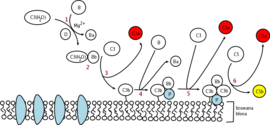
Alternative complement pathway
Encyclopedia


Complement system
The complement system helps or “complements” the ability of antibodies and phagocytic cells to clear pathogens from an organism. It is part of the immune system called the innate immune system that is not adaptable and does not change over the course of an individual's lifetime...
is an innate
Innate immune system
The innate immune system, also known as non-specific immune system and secondary line of defence, comprises the cells and mechanisms that defend the host from infection by other organisms in a non-specific manner...
component of the immune system
Immune system
An immune system is a system of biological structures and processes within an organism that protects against disease by identifying and killing pathogens and tumor cells. It detects a wide variety of agents, from viruses to parasitic worms, and needs to distinguish them from the organism's own...
's natural defense against infections, which can operate without antibody participation.
The alternative pathway is one of three complement pathways that opsonize and kill pathogens. The alternative pathway does not require a specific antibody to commence, and, so, can be effectively much faster than if antibody synthesis had to take place, as in the classical pathway. Rather, the C3 protein directly binds the microbe. The caveat of this faster activation is that only specific types of antigens can activate this pathway.
Cascade
It is initiated by the spontaneous hydrolysisHydrolysis
Hydrolysis is a chemical reaction during which molecules of water are split into hydrogen cations and hydroxide anions in the process of a chemical mechanism. It is the type of reaction that is used to break down certain polymers, especially those made by condensation polymerization...
of C3
C3 (complement)
Complement component 3, often simply called C3, is a protein of the immune system. It plays a central role in the complement system and contributes to innate immunity. In humans it is encoded on chromosome 19 by a gene called C3.-Function:...
, which is abundant in the plasma in the blood.
"Tickover" occurs through the spontaneous cleavage of the thioester bond in C3 to form C3(H2O).
This change in shape allows the binding of plasma protein Factor B, which allows Factor D to cleave Factor B into Ba and Bb.
Bb remains part of the C3(H2O) to form C3(H2O)Bb. This complex is also known as a fluid-phase C3 convertase. This convertase, although only produced in small amounts, can cleave multiple C3 proteins into C3a and C3b.
The alternative pathway C3-convertase consists of the activated B and D factors, forming an unstable compound that can become stable after binding properdin
Properdin
Properdin or factor P is a globulin protein found in the blood serum of more complex animals. In the complement system, an innate-immunity series of proenzymes dissolved in the circulation, it is also called "Factor P".-Function:...
, a serum protein.
After the creation of C3 convertase, the complement system follows the same path regardless of the means of activation (alternative, classical, or MBL). Binding of another C3b-fragment to the C3-convertase of the alternative pathway creates a C5-convertase analoguous to the MBL or classical pathway.
The C5-convertase of the alternative pathway consists of C3bBbC3b also referred to as C3b2Bb (instead of C4b2a3b in the other pathways)
Regulation
Since C3b is free and abundant in the plasma, it can bind to either a host cell or a pathogen surface. To prevent complement activation from proceeding on the host cell, there are several different kinds of regulatory proteins that disrupt the complement activation process:- Complement Receptor 1 (CR1 or CD35) and DAF (decay accelerating factorDecay accelerating factorComplement decay-accelerating factor also known as CD55 is a protein that, in humans, is encoded by the CD55 gene.Decay accelerating factor is a 70 kDa membrane protein that regulates the complement system on the cell surface...
also known as CD55) compete with Factor B in binding with C3b on the cell surface and can even remove Bb from an already formed C3bBb complex - The formation of a C3 convertase can also be prevented when a plasma protease called Factor I cleaves C3b into its inactive form, iC3b. Factor I requires a C3b-binding protein cofactor such as complement factor H, CR1 and Membrane Cofactor of Proteolysis (MCP or CD46CD46CD46 complement regulatory protein also known as CD46 and Membrane Cofactor Protein is a protein which in humans is encoded by the CD46 gene. CD46 is an inhibitory complement receptor.- Gene :...
) - Complement Factor HFactor HFactor H is a member of the regulators of complement activation family and is a complement control protein. It is a large , soluble glycoprotein that circulates in human plasma...
can inhibit the formation of the C3 convertase by competing with factor B for binding to C3b; accelerate the decay of the C3 convertase; and act as a cofactor for Factor I-mediated cleavage of C3b. Complement factor H preferentially binds to vertebrate cells (because of affinity for sialic acid residues), allowing preferential protection of host (as opposed to bacterial) cells from complement-mediated damage. - CFHR5CFHR5Complement factor H-related protein 5 is a protein that in humans is encoded by the CFHR5 gene.-Function:CFHR5 is structurally related to complement factor H which plays an important role in the regulation of a branch of the innate immune system called the alternative complement pathway...
(Complement Factor H-Related protein 5) is able to bind to act as a cofactor for Factor I, has decay accelerating activity and is able to bind preferentially to C3b at host surfaces.
Further reading
- Immunobiology. Janeway, et al. 5th 3ed. ISBN 0-8153-4101-6. (5th ed. text online at http://www.ncbi.nlm.nih.gov/books/bv.fcgi?call=bv.View..ShowTOC&rid=imm.TOC&depth=10.)
- BioCarta's diagram of the alternative pathway, http://www.biocarta.com/pathfiles/h_alternativePathway.asp

